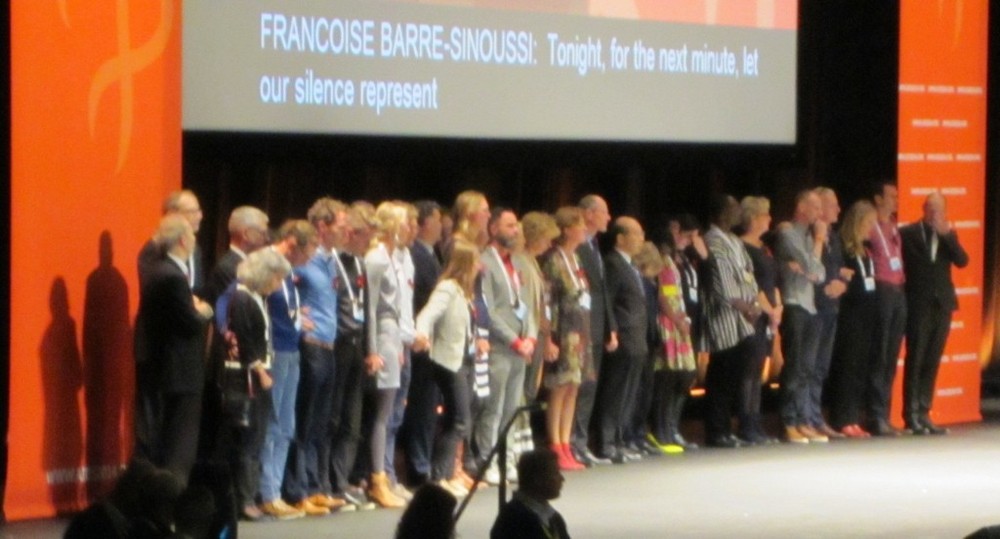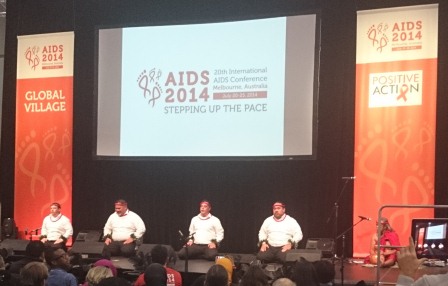SUZANNE O'CALLAGHAN
Suzanne O'Callaghan is Policy Research and Education Manager, Haemophilia Foundation Australia
Photo right: Jenny Ross at the Witness Seminar
Photo: HFA
AIDS 2014, the International AIDS Conference, was held in Melbourne in July 2014 – and with nearly 14,000 delegates from all parts of the world was a massive international meeting. I was grateful to receive a scholarship from the Australian Government to attend this extraordinary event. What a great opportunity to hear the latest information on HIV and meet with HIV workers and organisations from Australia and around the world!
It began on a very sombre note with the news that a number of very well-known delegates had lost their lives on flight MH17 on their way to the AIDS Conference. The tributes to the delegates highlighted the determination of all to continue their work, and the Conference went on, very motivated to achieve its goal of stepping up the pace to end the HIV epidemic.

Colleagues lead a minute’s silence for the delegates lost on MH17
Photo: HFA
This meeting was held in the two days prior to the AIDS Conference and focused on the new range of Direct Acting Antiviral (DAA) hepatitis C treatments that are beginning to go through approval processes internationally.
It was particularly interesting to hear that hepatitis specialists are more confident that these new treatments will be safe and effective for people with HIV/HCV co-infection. One presentation noted that, after the European approval of new DAAs for use in chronic hepatitis C, the European Association for Study of the Liver (EASL) Guidelines now recommend treating HIV/HCV co-infection the same as HCV mono-infection, with some attention to potential HIV antiviral drug interactions. HIV drug interaction clinical trials with each of the new DAAs will be important to understand drug safety, but the recommendation now is that they are done earlier so that they can be available at the time of approval, and are part of the decision-making about indications for treatment.
As part of the Conference’s work to understand the ongoing impact of HIV on the community, there are also several events to recognise and remember the experiences of people with HIV (PLHIV) in Australia, including people with bleeding disorders. One of these was the Witness Seminar, paying tribute to the Australian response to AIDS in the 1980s. Jenny Ross, who was HFA President at the time, took a leading role in the national response and attended the Seminar with Sharon Caris and myself. Dr Roger Garsia, a clinical immunologist from the Royal Prince Alfred Hospital in Sydney, also spoke about difficulties with discrimination during that period and his experiences with arranging blood sample testing for people with haemophilia – there was such fear of transmission among the couriers that he drove the blood samples to the Reference Laboratory in Melbourne himself. It was an important and memorable reminder of the tremendous – and in many cases, lasting – impact on the bleeding disorders community.
With the improvements in HIV treatments, people with HIV (PLHIV) in Australia are now living into their senior years. Several sessions dealt with issues of ageing and some interesting points were made:
One of the issues with growing older is that the person with HIV may need supported accommodation in a residential aged care facility, like a hostel or nursing home. Research on this shows:

Global Village: Male peer support – a Hawaiian PLHIV hula troupe
Photo: HFA
Overall there was quite a celebration of ageing with HIV at the Conference, with an attractive photographic display inviting older delegates with HIV to participate. The importance of peer support was also acknowledged. One presenter noted that peer support can be very valuable in maintaining wellbeing, particularly if the peer is a similar age. A weekly phone call to touch base can make all the difference with depression. It was great to see some of the peer strategies already used by Haemophilia Foundations, such as “old boy” lunches and regular social contact, being validated in an international forum!
Haemophilia Foundation Australia acknowledges the Traditional Owners and Custodians of Country throughout Australia, the land, waters and community where we walk, live, meet and work. We pay our respects to Elders past and present and extend that respect to all Aboriginal and Torres Strait Islander peoples.
Sign up for the latest news, events and our free National Haemophilia magazine